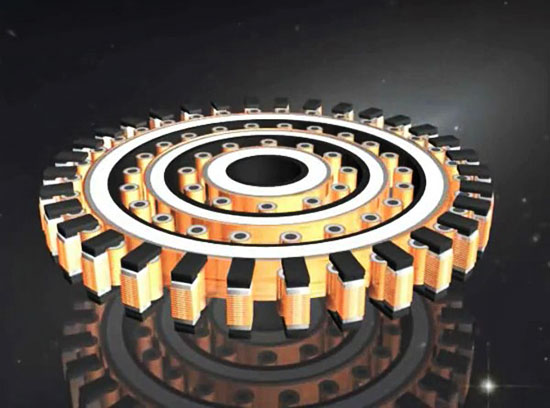|
2016
(1917 - 2008)
Clarke's first
law
Searl Effect Generator
It is a magnetic prime
mover of electromagnetic multi-phased cylindrical rollers over fixed
stator rings and free of any mechanical wear or friction.
In this manner, each roller can also induce eddy currents of mutual induction between the copper surfaces to form a frictionless 'magnetic bearing' as it generates radial electrical potentials.
Frictionless operation enables the SEG to operate without physical
wear and thus enabling it to operate with a service expectancy of a
lifetime.
showing the four material component
layers
Surrounding each of the Plates is rotors (called rollers) constructed with the same materials but are free to rotate around the Plates.
The inner most Plate typically has 12 rollers, 22 on the second stage and 32 on the final Plate. Surrounding the outer most rollers are conventional electromagnets, which by way of magnetic induction taps energy out of the rapid passing of magnetized rollers.
These inductive pickup coils are connected in various
configurations to supply AC power at a variety of desired voltage
and current levels to suit residential or industrial applications.
12 of the 2,124 components make the 3 plates that act as reaction components. 2,112 components are employed to create 66 roller sets that also act as active components.
Each roller set consists of 8 segments constructed from
32 components.
Therefore the smallest roller
set must weigh 272 grams, making a grand total of 2,244 grams per
roller set for the smallest surface bound SEG.
The inner transformer output is fed in to the input of the second plate which increases the output of the second unit, which output feeds as an input to the final unit, thereby increasing its final output to a very high voltage.
The output windings can be designed to step down
the output to a standard 240 volts at the rate of about 15 Kilowatts
for a home unit.
In 1968, it became clear that these magnetic bubbles contained particles in a set manner and that there was a set pattern to how many bubbles were present in the material.
Because of this finding, John R. R. Searl dropped the term 'magnetic bubbles' and replace it with the term 'magnetic quantum material' and released these details in a newsletter which has since been reproduced in one of Searl's books a few years ago.
A laboratory examination also agrees that somehow the
material changes its state when produced in this manner.
This process is assisted
by
the highly electron-attracting or capturing effect of the neodymium
layer.
Visit
Breakthrough Magnetic Waveform Technology...
|




